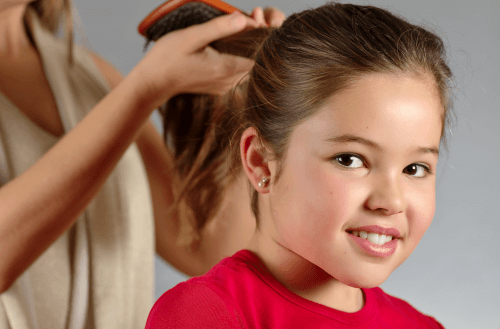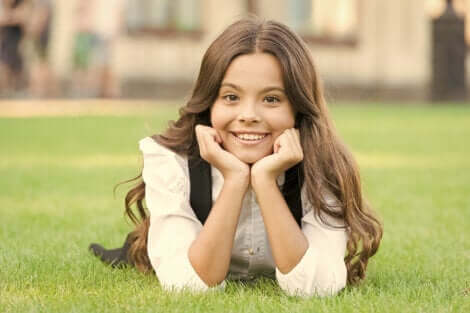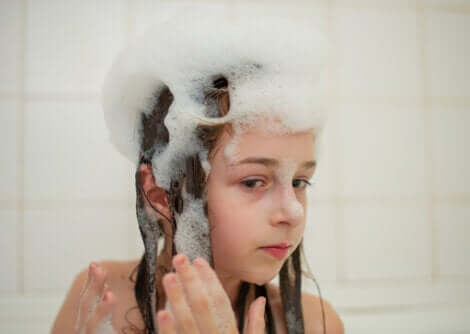Top Tips to Help Your Children's Hair Grow Strong and Beautiful


Written and verified by psychologist Valeria Sabater
Children’s hair will usually change dramatically over time. When they’re an infant, it isn’t uncommon for them to have very little hair, but before you know it, it’s suddenly multiplied. That’s why it’s a good idea to know how best to care for your children’s hair so it grows as strong and beautiful as possible.
Now, it’s convenient to bear in mind that, in addition to the use of conventional products, hair requires certain routine guidelines to stay radiant and free of aggressions. Thus, you’ll have to teach your children how to take care of it every day.
Characteristics of hair growth in children
First of all, don’t worry if your baby was born with very little hair, or if it doesn’t grow much over the first few months. This is totally normal. Every child has a different hair growth pattern. You simply have to be patient.
As this publication from Clinics in Dermatology explains, by the time they’re three years old, their hair will normally cover their entire head. Needless to say, hair color can vary greatly. It can also be straight, wavy, or curly, among other options.
In addition, it’s important to remember that the hair color your baby’s born with isn’t necessarily the color they’ll have their entire life. In fact, plenty of children are born with blond hair, which ends up slowly darkening over time. The same goes for their eyes.
What’s the reason for these changes? The melanin-producing cells in infants are still very immature, meaning that they aren’t yet able to create the definitive hair and eye colors predetermined by their genetics.

Nutrition to help your children’s hair grow strong
As you know, children need a balanced and varied diet that’s rich in vitamins, minerals, proteins, and antioxidants. But what kinds of nutrients will help their hair grow better and stronger?
One example is Vitamin B (biotin), which is a recommended vitamin for minors. Although the evidence is limited, a study published in Skin Appendage Disorders determined that this nutrient helped reduce excessive hair loss.
In addition, as observed in an investigation published in Dermatology and Therapy, vitamin and mineral deficiencies, such as Vitamins A, B, C, D and E, iron, selenium, and zinc, can impact capillary health and cause problems such as alopecia.
Due to what we mentioned above, it’s ideal to incorporate some foods that contain such nutrients into your children’s diet. In general, experts recommend the following foods:
- Fruit and vegetables
- Legumes
- Whole-wheat cereals
- Oily fish
- Lean meats
- Dairy products
You might like: Minoxidil: Treatment for Alopecia and Hair Loss
Children’s hair care
The American Academy of Dermatology states that it’s important for parents to teach their children to take care of their hair so that it grows healthy and beautiful. In this regard, it states that many common practices affect hair and reduce its natural shine.
What cares should you take into account? For your children’s hair to stay healthy, it’s convenient that you improve the way you wash it, as well as the products you choose to treat it. Here are some tips:
1. How often should you wash your children’s hair?
According to a study published in the International Journal of Trichology, how often you wash your children’s hair will depend on personal preference and is often influenced by factors such as hair length and culture, among others.
This same publication notes that regular, frequent washing with a well-formulated shampoo won’t damage your children’s hair. Thus, you can wash your children’s hair regularly, as long as you use suitable products that respect its natural pH.

How often you wash your children’s hair depends on their hair type, according to the American Academy of Dermatology. However, in general. it isn’t harmful to wash it regularly if you use suitable products.
2. Hair that’s hard to comb
It’s normal for long hair to easily get knotted and be difficult to comb or brush. You may already know that it’s important to brush hair two to three times a day. In addition, you need to do it carefully, as you can break it otherwise.
To make this process easier, the American Academy of Dermatology advises people to use a wide tooth comb more often than brushes and, of course, to use conditioner.
You should also read: 8 Bad Habits that Affect Your Hair Health
3. Avoid using hot styling tools
There’s nothing wrong with curling or straightening your child’s hair for a party or another event. However, to avoid aggressions or hair problems, you should avoid the use of these hot styling tools as much as possible.
As a study published in the International Journal of Cosmetic Science, these tools damage hair keratin and can lead to dryness and hair loss.
Healthy habits to care for your children’s hair
In addition to what we mentioned here, it’s worth noting the importance of teaching children good habits, so that they take care of their hair and their health. Thus, getting good sleep, exercising, and avoiding the consumption of sweets and processed foods can also help keep your hair healthy and strong. Keep that in mind!
All cited sources were thoroughly reviewed by our team to ensure their quality, reliability, currency, and validity. The bibliography of this article was considered reliable and of academic or scientific accuracy.
- Wade, M. S., & Sinclair, R. D. (2002). Disorders of hair in infants and children other than alopecia. Clinics in Dermatology, 20(1), 16–28. https://doi.org/10.1016/S0738-081X(01)00226-7
- Almohanna HM, Ahmed AA, Tsatalis JP, Tosti A. The Role of Vitamins and Minerals in Hair Loss: A Review. Dermatol Ther (Heidelb). 2019;9(1):51–70. doi:10.1007/s13555-018-0278-6
- Asifa N, Kusagur MS, SugaReddy. Prevalent Practices and Perceptions in Hair Cleansing. Int J Trichology. 2017;9(3):136–137. doi:10.4103/ijt.ijt_41_16
- Zhou, Y & Rigoletto, Ray & Koelmel, D & Zhang, Guojin & Gillece, Tim & Foltis, Linda & Moore, David & Qu, X & Sun, C. (2011). The effect of various cosmetic pretreatments on protecting hair from thermal damage by hot flat ironing. Journal of cosmetic science. 62. 265-82.
This text is provided for informational purposes only and does not replace consultation with a professional. If in doubt, consult your specialist.








